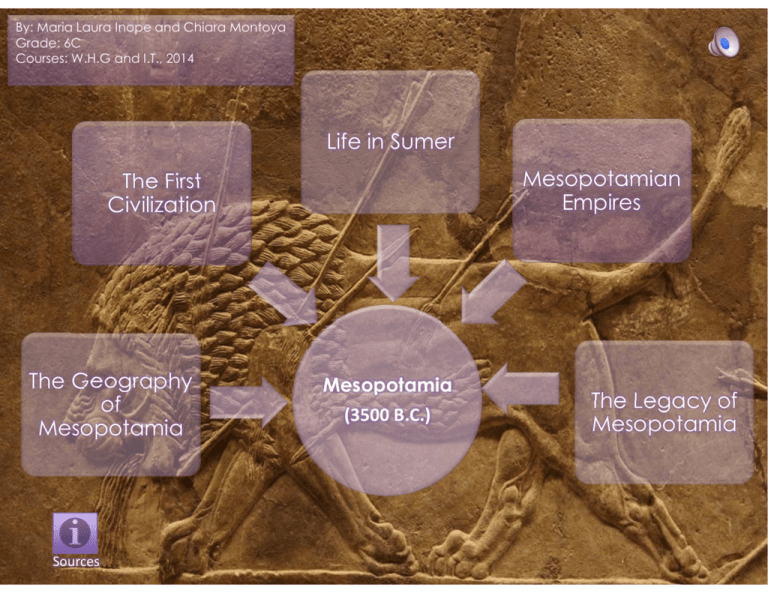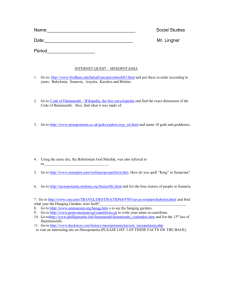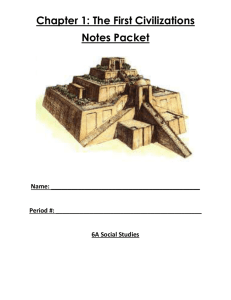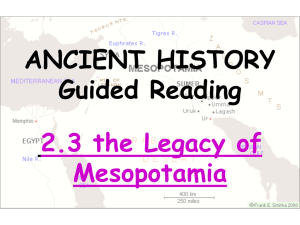The Geography of Mesopotamia The First Civilization Life in Sumer
advertisement

By: Maria Laura Inope and Chiara Montoya Grade: 6C Courses: W.H.G and I.T., 2014 Life in Sumer Mesopotamian Empires The First Civilization The Geography of Mesopotamia Sources Mesopotamia (3500 B.C.) The Legacy of Mesopotamia The Geography of Mesopotamia • Mesopotamia means "Land between rivers"( Tigris and Euphrates).These rivers provided water, a means of travel, and food. There was fertile soil because of silt, fine soil deposited by a river. This silt was brought by the rivers onto the floodplains the flat land bordering the banks. Climate: Semiarid ( half dry/semi deco).Water: Controlled by irrigation and dams. Unpredictable floods/ Unpredictable droughts. • They lacked stone wood and metal. They surplus, Grain more grain than needed,(used for trade).Buildings made with mud. The First Civilization • • • 1. 2. 3. 4. 5. • • • • • • Over time, villages grew larger and became cities. Society and culture grew more complex, developing into an advanced form of culture called... Civilization. The first civilization rose in the region of Sumer, Mesopotamia(3300b.c). Five traits of characteristics of an civilization: Advanced cities Specialized workers Complex institutions Record keeping Advanced technology City state, a city and its nearby farmlands. Most of them where near the mouth of the Tigris and Euphrates Rivers. Sumer had at least 12 self-ruled city-state. Cities: centers of trade, learning and religions with walls, narrow (“angosto”), winding (zigzag) streets & mud houses. Sumerians believed in many gods and goddesses. This is called Polytheism. The largest and most important structure in a Sumerian city was a temple: Ziggurat. Leaders:1st priest 2nd judges 3rd kings (the highest-ranked leader of a group). Life in Sumer • Sumerian Society: King priest, landowners, government officials, rich merchants, free people (many artisans and farmers), slaves. • Plow, wheel, potter`s wheel, bronze (copper + tin). • Development of Mathematics: Arithmetic, to keep records of crops and trade goods, number 60 & geometric shapes. • 1st Pictures of objects, 2nd Pictographs (picture writing) which were symbols for these objects,3 rd Cuneifrom or wedge writing (600 symbols for objects & ideas). • Record keepers: Scribes, people who specialized in writing, wrote with a stylus, a sharpened reed. Mesopotamian Empires • King Sargon of Akkad: Creator of the 1st Empire (a form of government that brings together many different people and lands under the control of one ruler). Sargon was also an emperor , (person who rules an empire). • He ruled in the Fertile crescent (lands that stretched in a curve from the Mediterranean sea though Mesopotamia, a Persian Gulf). Empires are important: they change the way people live. Empires bring peace to the people there. They encourage trade. Empires spread ideas, technology, and customs. • • • • • King Hammurabi of Babylonian Empire, also he ruled it. He created the first code of laws, a set of written rules for people to obey . Hammurabi's code was written in cuneiform and the goal of this goal was to justice, fail treatment of people plus protection to all, women and men. Hammurabi's code set out the belief that society should be run bye the code of law. Hammurabi's code of laws sometimes called eye for an eye code, and includes 282 laws converging bussing, property to conduct toward other people. The Legacy of Mesopotamia • • • • • • • • • • • • • • • • • 1st Writing 1st Code of laws “Hammurabi” Wheel 1st Library 1st Empire Irrigation System (Dike, Canals) Hanging Gardens 1st Calendar (Months and Weeks) 1st Civilization Plow Wagons Potter’s Wheel Bronze Items Mathematics (Arithmetic and Shapes) Stylus Board Games Wheel Chariot Sources in M.L.A. Format • NEWSPAPER "Mesopotamia: La primera civilización de la humanidad". Expreso. 18 de mayo 2014: Enciclopedia Escolar. Impreso. • BOOK Carnine, Douglas. et al. World History Ancient Civilization. Primera Edición. Evanston: McDougal Litell,2006.Impreso.






